In my yard, the most damaging, relentless, and challenging pest to control has been gophers. Birds peck plums and squirrels may steal plums, but a gopher will kill a plum tree. While I haven’t lost any plum trees to gophers, I’ve lost other fruit trees and innumerable vegetables.
The cruelest attack by gophers has been to the Sharwil avocado tree that I planted when my son was born. I’ve now killed three gophers attacking that special tree over the past couple years. Most recently, I trapped and killed one with a Cinch trap. (See photo above.)
I’ve tried almost every method I’ve heard of to control gophers over the years. I’ve found trapping to be the best general method, and about a year ago I discovered the Cinch trap in particular and haven’t used any other method or trap since.
How the Cinch trap works
Here’s how I recently set a Cinch trap after I noticed this gopher mound in my strawberry patch.
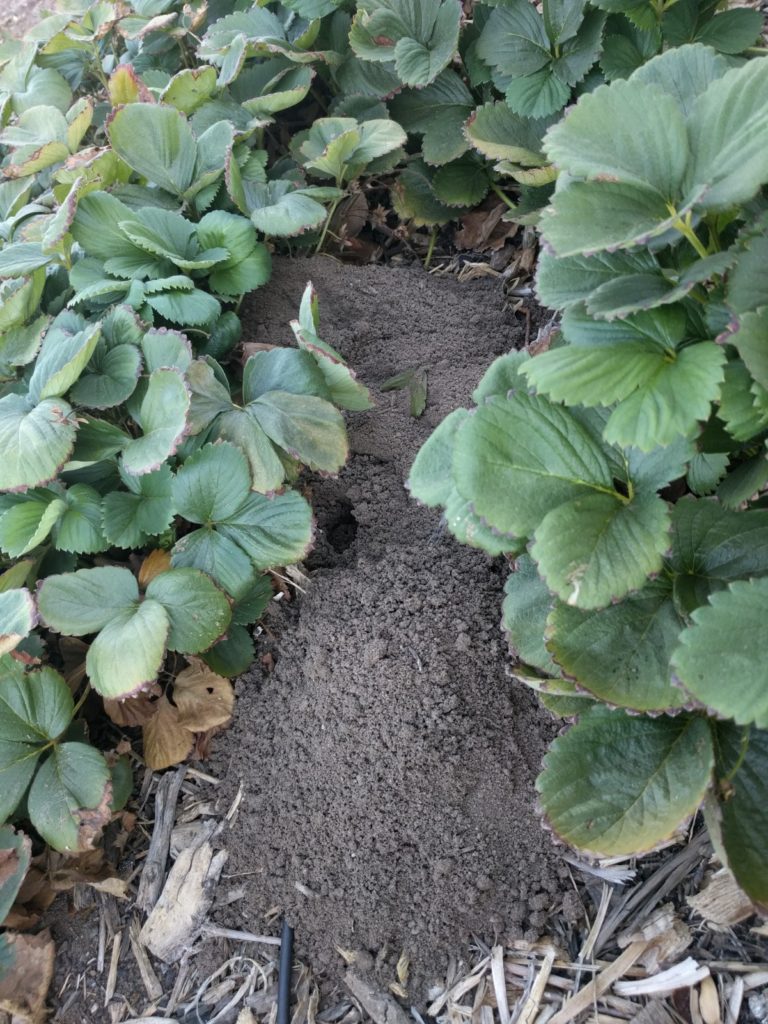
I poked my hori-hori knife into the mound and located the attached gopher tunnel, and then I cleared the dirt out of the tunnel.

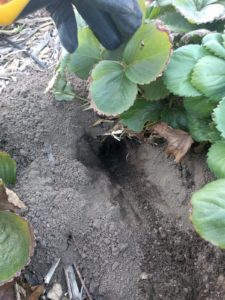
After setting the Cinch trap, I slid it into the tunnel.
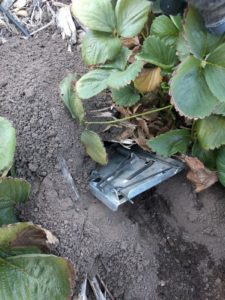
Here’s what the gopher might see from its angle inside the tunnel:
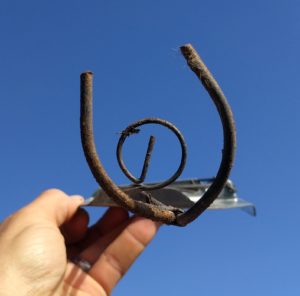
Those arms on either side are spring-loaded and will pinch tight to instantly kill the gopher when its nose pushes the center piece to release the spring action.
It so happens that I didn’t end up catching a gopher with this particular Cinch trap setting because my cat caught it first. She presented the head on our front porch that evening. If only she did that consistently.
Other methods unsatisfactory
Cats and other methods of gopher control that I’ve used have been less than satisfactory compared to traps in general, let alone the Cinch in particular. Here’s why:
1. Collapsing tunnels: gophers are digging machines, they don’t mind at all, they dig new ones immediately
2. Filling tunnels with water: nothing ever happened, it might be because my soil is so sandy and well draining
3. Strychnine poison bait: don’t get to see the baits effectiveness, can poison pets and wildlife unwittingly
4. Snakes: we’ve got them in our yard, but the evidence shows that they don’t eat enough gophers
5. Owls and hawks: we’ve got plenty of them in our neighborhood, but they don’t catch enough
6. Pellet gun: it’s very satisfying to shoot a gopher, but it isn’t a reliable method to control them in large numbers
7. Shovels: it’s also very satisfying to smash a gopher with a shovel, but they rarely show themselves above ground
Trapping is the best method
Traps have worked better than any of the above methods for me. Before using the Cinch trap, I used other pincher-style traps made by Victor and Macabee. I also used Victor’s Black Box trap.
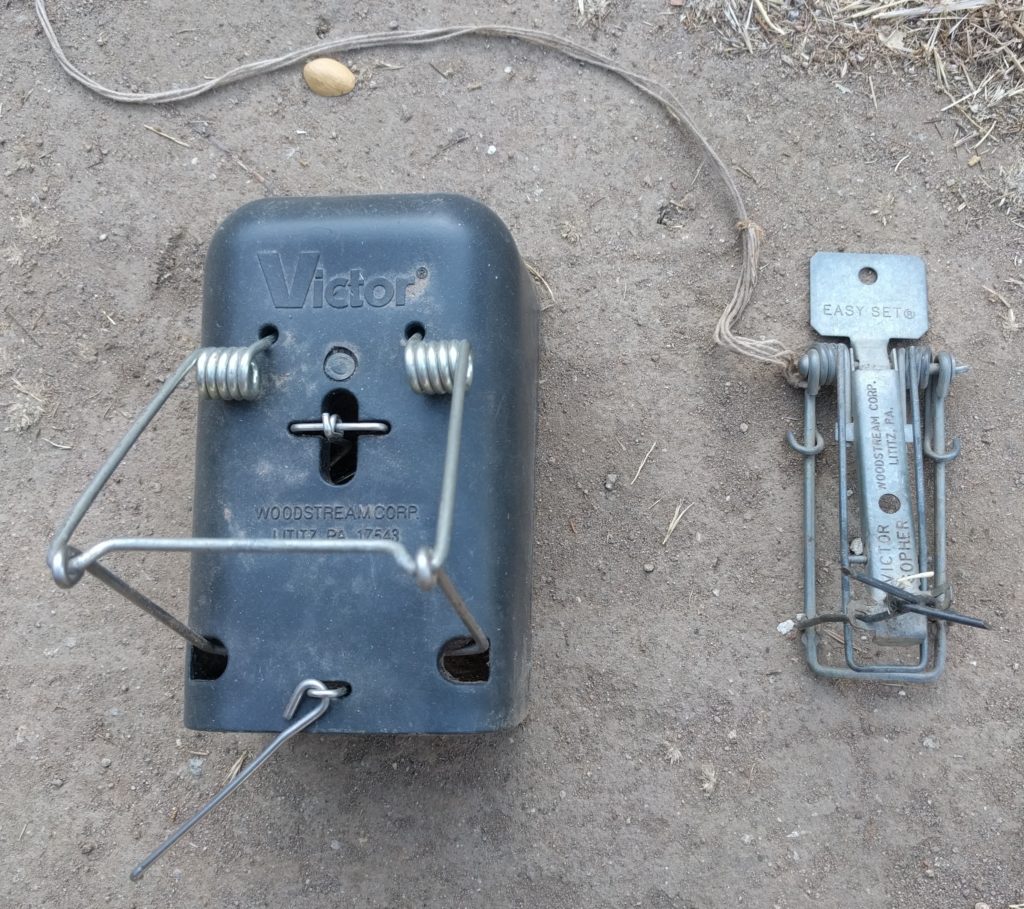
In general, I’ve preferred trapping as a method because you know without a doubt when you’ve caught the gopher, it’s not as time-consuming as some other methods (you set the trap and walk away while it does its work), there are no risks of collateral damage like with using poisons, and most importantly, trapping works. It gets the gophers.
Cinch trap advantages
Victor and Macabee pincher traps work, no doubt. I’ve killed many gophers with them. Nevertheless, I’ve found the Cinch trap to be superior in a number of ways, which is why I no longer use those other traps. (Some friends get good results with the Gophinator trap, but I’ve yet to try that one.) Here are the reasons I prefer the Cinch trap:
1. Less digging: all you do is open up the gopher’s tunnel instead of excavating a giant hole in order to find the gopher’s horizontal runway
2. Fewer tools and other materials needed: with the Cinch you don’t need a shovel, a hole cover, or wire attached to the trap
3. Highest catch rate: in my experience, the Cinch simply catches gophers more often
4. Cleaner: rarely is there any blood with a Cinch catch, and releasing the gopher from the grip of the trap is easier too

My personal keys to effectively using Cinch traps
The Cinch trap is, in the end, only a tool. And any tool is no more effective than the tool’s handler. While I was catching gophers with the Cinch trap right off the bat, I’ve increased my effectiveness through doing or learning a few key things. Many of the most useful things I’ve learned have come through watching the videos of Thomas Wittman on YouTube and following his advice. Wittman owns a company called Gophers Limited based in Santa Cruz, California, and the guy knows what he’s doing.
From Wittman, I’ve learned how to hold the trap optimally while setting it (which requires some strength), how to position it in the tunnel, and where to poke into a gopher mound to find the tunnel in the first place. To do that poking, I’ve bought a hori-hori knife as Wittman suggests, which helps open the gopher’s tunnel to the right diameter so that the Cinch trap fits snugly in it. Prior to buying the hori-hori, I used a trowel or stick or my hands, all of which didn’t work as well.
I’ve also learned from Wittman not to quit on a mound if the trap doesn’t work the first time. If the gopher plugs the tunnel, just open it up again and reset the trap. I’ve now caught many gophers by resetting failed first attempts.
Lastly, I keep a can of lubricant (such as WD-40) in my bucket of Cinch traps and tools because over the years the traps rust. A little spray of lubricant every now and then keeps them sliding smoothly.
Where to buy Cinch traps
So maybe you’d like to try out a Cinch trap in your yard? You can buy one directly from the manufacturer through their website, Cinchtraps.com. This is where I bought my last couple traps. You can also get them at the Gophers Limited website. Be sure to buy the small size, which is suitable for trapping pocket gophers in California.
(Just to be clear, I have no relationship with Thomas Wittman, Gophers Limited, or Cinch. I’m sharing my experiences here only to help others who are struggling with gophers damaging their vegetables and fruit trees like me.)
Also, if you’d like to get a hori-hori knife, don’t bother paying a lot if you’re just using it for gopher trapping. I bought the Fiskars hori-hori knife in the photo above at Home Depot for about $15. There are lots of prettier and more expensive ones around, but you don’t need such a thing for setting Cinch traps.
Lastly, if you’d like to do some deeper reading on how gophers dig, breed, and feed, this University of California page can’t be beat. Good luck getting those gophers!
You might also like to read my post: “Managing rabbits in the garden.”

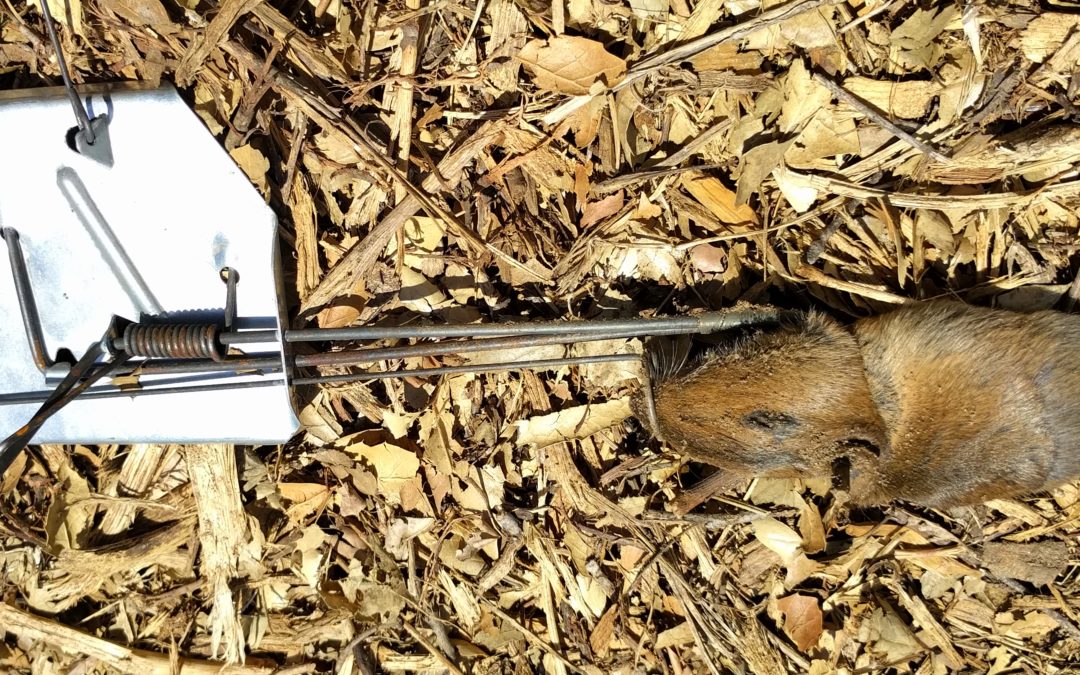


Great post.
I concur; I live on a acre east of San Diego where I planted about forty fruit trees in the last four years. I’ve used six Cinch traps to kill 150 gophers in six years. They are easy to set and work great.
A few tips:
1) Use WD40 to keep the traps from rusting. The gophers don’t mind it
2) The the tunnel from the surface connects at an angle to another tunnel at some point. If that point is about eight or ten inches down the tunnel from the surface, then the round jaws of the trap will be just about at the intersection. In that situation I find that the trap often gets sprung without catching a gopher, and that’s bad because it trains that gopher to avoid your traps in the future, plus it wastes your time. See the next tip for the solution.
3) If you find a trap sprung, but with no gopher in it, you probably have the situation described above, or maybe something else is wrong with your hole. Either way, what I do is dig down along the failed tunnel until I hit the horizontal tunnel that it connects to (usually only about ten inches). Then I dig out a section along that horizontal tunnel that is about eight inches wide and fifteen inches long. The gopher tunnel will be open at each end of my hole, and I set a Cinch trap, horizontally, into each opening of the tunnel, pointing in opposite directions. The gopher will come from one direction or the other to investigate the opening, and I’ll get him.
4) I bought a very long pointy screwdriver cheap at Harbor Freight and it’s useful for poking around in a fresh fluffy gopher mound to find the opening, and the direction of the tunnel. I also use it to feel the difference between a lightly plugged or obscured tunnel, and the surrounding firm dirt.
5) Gophers are often inactive (hiding) during the day and become more (feel safe) just after dark. They are much more likely to be caught during that hour than during the day. I check my traps about an hour after dark. That way, if one is sprung, but empty, I can dig deeper and reset the trap. If I’ve caught one, I can retrieve the trap(s) set for that gopher and reset them right then on other new mounds that I didn’t have enough traps to address before. Waiting until morning would mean I’d have to wait 23 hours for that next magic hour after dark.
6) Tip 5 above is important because you want to kill as many gophers as you can as early in the spring as possible, before they start having babies! I start as soon as the rains come and the weeds start growing in February. Set a trap on every fresh mound you see as soon as you see it, until there are no more mounds.
7) After you’ve killed a gopher, try to stomp down/collapse the tunnel for a few feet in each direction (a pick axe is useful for this) and fill it in with the dirt from the mound. That way, if a new gopher ever tries to use that old tunnel, he’ll need to clear out the dirt from the collapsed section by pushing it up to the surface, and you’ll notice it.
8) When there are no more mounds, don’t quit yet. Look at the old dry abandoned holes (if you have any) to see if there is fluffy dark dirt in them up to surface level, but no mound. That’s what it looks like when a new gopher moves into an abandoned tunnel. Dig that fresh dirt out and set a trap.
Good hunting!
Awesome tips, every single one of them. Thank you, Conrad.
I live in Petaluma (Sonoma) and with the lack if rain, gophers have been horrible. My motto was to just try and manage them, we can never get rid if them. This info was great. I like the Victor box trap (i bait them with wild strawberry) but seems like the company isn’t making them anymore. Don’t like the new ones, so I’m goong to try the cinch trap. Good tip
with the wd-40. Thanks guys!
Hello Greg, This will be a good year for gophers, have you ever used the gas type in the tunnels and igniting it? Years back I had a friend who used this type told me that the gas was effective within a radius of 20′. I did think about getting the tanks and equipment needed for my issues but the price was out of my range. I have a friend that sets up coffee plantations as well as avocado orchards, he told me the best trap is MaCabee golfer trap. They had tried many traps and for them this trap worked the best. Do you sell your Gems? If so, I would like to purchase some. Never tasted a Gem and looking forward to receiving my trees soon.
As always it’s a pleasure reading your posts!!!
A few years ago my husband tried many traps and methods without luck, sometimes looking like Bill Murray with the hose in Caddy Shack. After years of this, one day I was at an organic gardening store in Palo Alto, and they had the Cinch and highly recommended it, so I bought one for him. He thought that I’d wasted our money and wanted me to return it, but I urged him to try it, and he caught one within a day! He came running into the house beaming and brimming with excitement and accolades. He has several Cinches now and we have turned other friends onto them who send us pictures of themselves with big smiles, dangling dead gophers from their traps! Those things work!
Greg my friend,
My daughter’s placenta Nabal avocado tree has gopher mounds on two sides of it, and so does my hass on the other side of the yard. I can see the little mounds of fresh dirt mixed in with my mulch so I know its gophers. I want to do everything I can to prevent these critters from killing my trees, especially the Nabal.
I bought two of the cinch traps, dug down to find the tunnels, and set them. Nothing. I let them sit there for 2-3 days and got nothing, so I took them out of the ground, filled up the holes, and went on with my life.
Yesterday, the mounds were back, so I dug down again and set another trap by the Nabal, but couldn’t find the tunnel near the hass. I found all kinds of beautiful healthy hass roots that I exposed which tore me up inside, and I never could find the tunnel near the hass. I stopped digging/looking for it since I had heartache about what I was doing to these fresh roots (hass is less than a year in the ground).
This morning, still nothing in the trap set in the tunnel by the Nabal. The traps don’t get sprung, they just aren’t catching the gopher.
What do you do when your traps don’t catch the gopher? Wait until you see another mound and set one there? Do you cover the holes you dug if you don’t catch him or leave the tunnel exposed? What do you do when you can’t find the tunnel?Do you ever feel like your digging for the tunnel does more harm to the tree than the gopher is?
Thanks for any help and guidance you can give.
Hi Keith,
Aah! I feel your urgency and frustration. Gophers are the worst.
If it is a fresh mound, then the gopher has plugged the tunnel that leads to it. Then if you open that plug, the gopher will discover the opening and plug it again. So if your traps haven’t been springing, then leave the tunnel open and check daily.
Eventually, the gopher will plug that opening. The longest I can remember that taking is about three days, but it usually happens within a day, sometimes within an hour or two. If the opening doesn’t get plugged, then there’s no gopher using that tunnel. Either a snake has entered and eaten it or who knows. Gophers do leave feeder tunnels open, but they don’t leave tunnels open that they have mounded and plugged, not in my experience.
If my trap isn’t getting sprung, sometimes I follow the tunnel back a foot or two farther, excavate, and set the Cinch trap there. This has worked many times.
I’ve noticed that gophers often make tunnels to a tree’s rootzone and then they circle. So if you’re having trouble finding the tunnel, poke a long screwdriver or metal rod around the circumference of the canopy to search for a tunnel.
It’s true that you end up damaging some roots in this process, but if you suspect a gopher has found the tree then it’s absolutely worth it. The gopher will do lethal damage very soon unless you catch it.
I rub my traps with fresh grass to hide any human smells that the gopher might pick up.
I have had good success with Victor cinch traps if I tie two together with 2 or 3 feet of wire and in the main tunnel insert one in each direction. Cover the lateral tunnel partially so just a little light shines in. When the gopher sees the light coming in, it will come to plug it and trip one of the traps.
Thanks for the post! It takes a little more time and effort, but I have made it a habit to surround the root ball (with some extra space for growth) of any new fruit tree I planted in the yard with gopher wire, creating a protected cage. I still see some gopher holes popping up in the yard, but all the trees are thriving. I recommend to all my friends who are planting trees to consider getting the gopher wire and making cages. All I do is dig the hole, then line it with the gopher wire with extra wire extended above ground, clamp the edges in the hole together with wire ties (although I imagine zip-ties will probably also work), plant the tree, and then fold the extra wire over the top of the soil. I leave a small circle around the trunk of the tree for growth. Then I put mulch over the top and you can’t see the wire mesh. Root ball snug and protected! Over time the gopher wire will break down and as tree roots push through the wire and thicken, the wire will bend and break to accommodate the roots. Gophers may chew through the outlying roots, but the ball will remain protected.
Thank you for all the great recommendations about the gophers. I was wondering if the wire would prohibit the growth of the trees in the long run. Also what size of the cage would work the best for a 5 gallon tree?
Hi Aram,
I don’t use these baskets, but I know that it’s claimed to not girdle the roots and affect the growth of the tree.
As Keith says above, you can size the cage just a bit bigger than the football/container, so maybe add a few inches to the diameter.
Based on your recommendation I purchased some Cinch traps and have been catching gophers in my yard the past few days with them. Thanks for the recommendation, as I waited way too long to get started on tihs. Anyway, I was watching one of the videos linked to above and saw that the person returned the dead gopher back to the hole it was trapped in. I’ve actually caught more than one gopher in the same hole (a rather large one under my mature Hass). I’ve heard that gophers are territorial, but I’m wondering what your experience is. In the trash or back in the hole? Do you catch more than one gopher in the same burrow ever?
Hi Matt,
Glad to hear you’re having luck with the Cinch traps. I’m catching a lot of gophers with them this time of year.
It so happens that I caught two in one tunnel system just the other day, but one of the gophers got caught backwards! My guess is that it was trying to enter the tunnel from the outside.
Why would it be trying to enter another gopher’s tunnel? Maybe to mate?
Gophers do seem to be territorial and don’t generally share tunnels though. I just leave the dead gopher in the tunnel too, but I also try to collapse as much of the tunnel as possible. That way when another gopher finds that dead gopher’s tunnels there will be fewer and the new gopher will likely start digging to expand them and I’ll see the mounds.
I will say the scissor type traps have their place too. However, they can be a pain to set and keep set inside a tunnel, and they require digging to use. But at times I find myself needing to dig anyway, and in those cases I use the scissor traps. I’ve caught nearly as many this year with the scissor traps (9) as the cinch(12).
But cinch is great. I was running out the door recently, saw a very fresh hole, stuck the cinch in it quickly against the left side of the tunnel and left. When I returned I had the gopher, although not in the jaws, but pinched to the tunnel as it tried to get by on the side. I’ve caught a couple more that way since. Big tip on always aligning the cinch trap to the left side of the tunnel.
So I took your advice on another topic, mulching. I sill have a few yards in the driveway to spread, and much already under all my fruit trees, and over sections of the lawn/weeds in my yard. So, what I’m noticing is that its hard to tell if/when gophers are active under the mulch. I saw one barely pushing up the mulch recently, but no tell tale mound of dirt, unless you move the mulch. Perhaps I put too much down, or I’ve killed all the dumb gophers and only the crafty ones are left?
Hi Matt,
I have discovered gopher tunnels under the mulch under fruit trees when I hadn’t expected them, too. Only a couple times has this resulted in real damage to young trees. Usually, I noticed mounds outside the mulched area and trapped them there.
Always after catching gophers, I try to follow their tunnels with my hori-hori knife and collapse them as far as I can, especially if they’re near a tree. That way if a new gopher comes to inhabit that tunnel system it will have to dig and I’ll see its excavation mound. This doesn’t work perfectly, but I think it helps.
I’ve trapped a lot with scissor traps but now I use a different method. I mounted a small gas engine onto a wheelbarrow and extended a heater hose from the exhaust pipe about ten feet long. When I see gopher activity i find the hole, the horizontal one is best but the verticals also work. I insert hose at least a foot, start the engine, give it about ten minutes. It floods all the tunnels which are interconnected. Usually I see no activity any more for weeks or months in that area. When done i plug the hole just enough to keep the fumes in. but leave the bigger depression i made with the shovel. That way if a gopher survives he/she will attempt to fill the depression with dirt. But it also tells me they need another treatment. This does not seem to hurt the plants or trees at all. If my cats find the dead gopher it doesn’t hurt them either. Once I saw exhaust coming out over one hundred feet away. Those tunnel systems can be vast. If I’m really ticked at that gopher I give him a little longer treatment. Any questions are welcome.
Hi Ian,
I was talking to a neighbor the other day who has tried this method in his yard to no avail, but our soil is sandy or sandy loam here and I think these soil types allow too much gas exchange for the method to be effective. Is your soil on the heavier side?
Hi Greg,
I have sandy soil which is why I give it at least 10 minutes run time some times more to accomplish the gopher elimination during the run time. I agree that heavy type clay soil would retain the fumes longer.
Thanks, Ian. I should add that I learned from a specialist in this area that if the soil moisture is high then fumigation is more effective. He recommended late winter or early spring as being the best season for this method.
Another good reason to use the cinch trap vs typical scissor traps. I have found 100% kill rate with the cinch traps. I have also found that the scissor traps often don’t kill, just capture and wound the gopher. So if you want the gopher gone, you need to take the next step and kill the gopher, or just let it suffer. I don’t like either choice there. Obviously I want the gopher gone, and killing is a sure option. But having the gopher suffer for minutes/hours between when it is caught and when I am able to kill it is no bueno.
Ever try using garlic?
Hi Michael,
Use garlic how? What were your thoughts there? Gophers don’t prefer eating garlic compared to other plants in my observations, but they’re happy to eat every other plant near garlic. Are you thinking that sticking some garlic in their tunnel would deter them? I’ve never tried that, but even sticking dead gophers in their tunnel just causes them to plug up that section and dig new tunnels nearby so I’d be surprised if that helped. Have you ever tried anything with garlic?
Very interesting on catching gophers . My Daughter who lives in Downey had problems with gophers. I live in Fresno took her a couple of auto flares. Told her to light flares an stick inside hole an cover. Check around an if see smoke coming out other places cover. It works. Don’t know if died or moved to neighborhood.
I’ve been using the Gopher Hawk for the past couple of years with good results. With the Hawk there’s no need to dig to a tunnel; you simply probe to find it, insert the tube wedge to enlarge the opening, then stick the trap in and pull the trap sleeve up to set the spring. When it’s sprung, the part sticking up shows yellow so you know it’s sprung. Most of the time, it cleanly kills, though I have had a couple of less than perfect kills, in which case I employ my henchman, Molly the Border Collie. Unlike the pinch traps, the Hawk doesn’t require really strong hands to set. They are about the same price as the Cinch trap. Ace Hardware carries them. https://www.youtube.com/watch?v=Ip8FNcj2C6A
Thanks, Judy. I’ve heard others who like the Gopher Hawk too. I haven’t tried it. I like the idea that it doesn’t require as much strength to set because it is true that the Cinch trap requires either strength or good technique to set.
i have a gopherhawk and I hate to say it, but it hasn’t done anything for me. I have a gopher that is killing my lawn and I have tried to set it where it is supposed to go a number of times and its never triggered, much less dealt with a gopher. Unfortunate because I really like the design (and their service is top notch). But either I am doing it wrong or I have really clever gophers. I am trying to use an audio spike right now. Though that also does not seem to work as I just woke up to a dirt mound on either side of the spike…
An update. In the end I used gopher gassers. It took a few attempts, but it worked. I do have wet soil with a decent amount of clay, so it’s probably more effective for me than it would be for someone with sandy loam soil.
I set a Cinch Gopher trap yesterday afternoon and it was gone this morning , I dug around the tunnel and never found it. I live alone so no one else could have removed it. I do not drink. Is this possible? Mark Waldor
Hi Mark,
It is possible! I don’t drink (when setting Cinch traps) either, but I lost one once. I also accidentally caught a young squirrel in a Cinch trap once. Other animals will enter gopher tunnels so it’s possible that another animal (snake, burrowing owl, squirrel, possum, who knows) just got an appendage caught in the trap and ran off with it. Just a guess.
This occurs because you likely caught a gopher, and then a hungry fox or turkey vulture carried it (and your trap) away!
Good idea, Thomas. I have also seen my cats do the same a couple times. Luckily, they didn’t take the traps and gophers too far so I was able to find the traps later.
Relative to gopher trapping. Many years ago we had a couple of great nurseries here in Redlands and Yucaipa that were run by the Newell family. One day I was asking Mrs. Newell about trapping gophers. Here response was to use a trap like a Macabee (long before the Cinch traps), chained and attached to a stake. Not too much new there. The rest of the response was interesting and has worked very effectively. “Drop a cotton ball or ball of tissue into the run behind your traps that has a few drops of perfume or cologne on it”. Being a smart ass I asked her what worked best. With a wry smile on her face she responded. “Well it Redlands so Ode to Joy or Chanel #5 would be best fore these gophers”. I do miss her and the nursery.
By the way, it has worked very well and I use cheap cologne or after shave from the 99 cent store.
On another note. Once in a while I will pull a trap that has not killed the gopher. I talked to a veterinarian friend and asked him about a good way to dispatch wounded animals in cases like this. His suggestion was to keep a paint can with a lid and a can of engine starting fluid (ether) on hand. When I encounter a live gopher I just place the animal with the trap in the can, spray some starting fluid in the can, and close the cover. The animal will have expires within a few minutes and can be disposed of.
There are other ways of course but this works for us.
Ground squirrels or gophers. I just rototilled my sad, missing onion row. Tunnels were apparent as I went, another lost crop. Replanting requiring more brainpower to find ways to thwart my 4 footed villains.
Greg, Great website with tons of wonderful and thorough information. I have gophers in my garden (I found out after 8 years living here). I had planted a bunch of trees in raised beds and I recently found a mound in the 16x4x1 ft raised bed where I have planted my avocados. Do you recommend removing the soil and installing galvanized steel hardware cloth or stainless steel at the bottom or just covering each plant with a basket? I am wondering which offers the best bang for the buck both in terms of effort and cost.